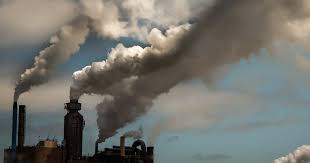The word pollution comes from the Latin ‘polluere’ that simply means contamination. Pollution is any undesirable change in physical, chemical or biological characteristics of air, land, water or soil. Agents that bring about such an undesirable change are called pollutants. Pollution affects the biodiversity of the ecosystem and poses a threat to the sustainability of the environment. In order to control environmental pollution, the Government of India has passed the Environment (Protection) Act, 1986 to protect and improve the quality of our environment (air, water, and soil).
Classification of Pollution:
- Generally, pollution can be classified as air pollution, water pollution, soil pollution, marine pollution, noise pollution, thermal pollution, and radioactive pollution.
- On the basis of part of the environment where it occurs pollution may be classified as air pollution, water pollution, and soil pollution.
- On the basis of the origin, the pollution may be classified as natural or anthropogenic (man-made).
- On the basis of the physical nature of pollutants, pollution can be classified as gaseous pollution, dust pollution, thermal pollution, noise pollution, and radioactive pollution.
Classification of Pollutants
- On the basis of the physical nature of pollutants, pollution can be classified as gaseous pollution, dust pollution, thermal pollution, noise pollution, and radioactive pollution.
- On the basis of ecosystem point of view, the pollutants can be classified as biodegradable pollutants and non-bio degradable pollutants.
Biodegradable pollutants are sewage, paper products, vegetables, juice, seeds, and leaves. These are pollutants that are broken down naturally by micro-organisms and are not harmful to the environment.
Non-bio degradable pollutants like plastics are substances which cannot be degraded by natural processes(decomposition by Saprophytes) easily.. They require millions of years to degrade. Nonbiodegradable pollutants are a threat to the environment. Other non-bio degradable pollutants are DDT, pesticides, insecticides, mercury, lead, arsenic, aluminium, radioactive substances.
Air Pollution:
Air pollution is the contamination of the natural air by mixing it with different pollutants such as harmful fumes and chemicals. This type of contamination can be caused by burning material or by gases emitted by vehicles or harmful fumes emitted as a by-product of industries.
Causes of Air Pollution:
Natural Causes:
Natural forms of pollution are those that result from naturally-occurring phenomena.
- Natural Particulate Matter: Particulate matter is the sum of all solid and liquid particles suspended in air, many of which are hazardous. Air can be contaminated by a range of natural particles such as dust, pollen, etc. In large areas that have little to no vegetation, and are particularly dry due to a lack of precipitation, wind can naturally create dust storms. During these storm dust particles and pollen grains are dispersed in the air.
- Wildfires: Forest fire originated by natural causes, i.e. without human activity involved, are also known as bushfires or wildfires. Wildfires are a natural occurrence in forests when prolonged hot and dry periods occur. Fallen leaves, dry grass or branches easily light up and can cause serious trouble to both urban and rural areas. Wildfires release pollutants like smoke, sulphur dioxide, nitrogen dioxide, ozone, particulate matter and carbon monoxide into the atmosphere.
- Animals: Animal digestion (particularly by cattle) leads to the release of methane, another greenhouse gas.
- Vegetation: In some regions plants like black gum, poplar, oak, and willow trees emit significant amounts of volatile organic compounds (VOCs) on warmer days. These VOCs react with primary anthropogenic pollutants specifically nitrogen oxides, sulfur dioxide and carbon compounds to produce low-lying seasonal hazes that are rich in ozone.
- Volcanic Activity: Volcanic eruptions are a major source of natural air pollution. When volcanoes erupt, they emit a mixture of gases and particles into the air. Active volcanoes are those from which lava, volcanic ashes, rocks, dust and gas compounds escape on a regular basis due to the phenomenon of volcanic eruptions. Sulphur dioxide and volcanic ash have been having a natural cooling effect, due to their ability to reflect solar radiation.
Anthropogenic (Man Made) Causes:
These causes include human reliance on fossil fuels, industrial activities accumulation of waste, modern agriculture, and other man-made processes.
- Household Activities: The main source of household air pollution is the indoor burning of fossil fuels, wood, and other biomass-based fuels to cook, heat and light homes. A still large population of the world has no access to cleaner efficient fuels.
- The Burning of Fossil Fuels: Fossil fuels include oil, natural gas, and coal. When these fossil fuels are burned, they release carbon dioxide, sulphur dioxide, methane, nitrogen, and particulates into the atmosphere. Pollution due to fossil fuels can take place from both natural and man-made processes.
- Combustion from Industry: Industrial operations and fossil fuel burning power plants can release pollutants into the environment. Manufacturing and petrochemical industries release a large amount of carbon monoxide, hydrocarbons, organic compounds, and chemicals into the air.
- Transportation Emissions: The gases emitting from automobiles cause an immense amount of pollution. Carbon Monoxide produced by incomplete combustion of fossil fuels in automobiles is another major pollutant along with nitrogen oxide. They also release particles in the air.
- Agricultural Activities: The major sources of air pollution from agriculture include livestock, rice paddies and burning of agricultural waste. Animal digestion (particularly by cattle) leads to the release of methane and the livestock is the main contributor of ammonia. Rice paddies produce methane. Heavily fertilized fields are the source of ammonia into the air. Use of insecticides, pesticides, and fertilizers in agricultural activities cause air, soil and water pollution. Farmers use machinery driven by fossil fuels to plow fields and harvest produce.
- Aerosols and CFCs: A colloidal suspension of particles dispersed in air or gas is called aerosols. Chlorofluorocarbons (CFCs) in aerosols are responsible for ozone layer destruction. The ozone layer helps shield the planet from dangerous ultraviolet rays.
